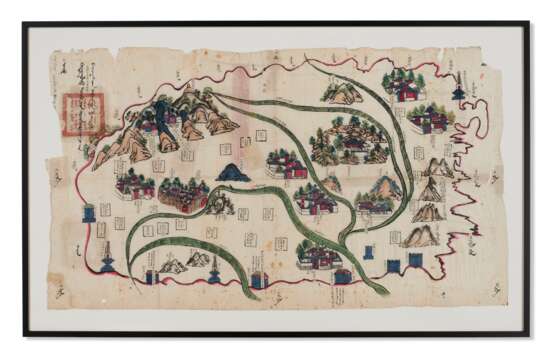ID 627601
Lot 112 | Eastern Tumed Right Banner, Inner Mongolia
Estimate value
$ 8 000 – 12 000
Manuscript map of the Eastern Tumed Right Banner in Inner Mongolia, produced by local government. The map is enclosed in a cloud-like shape with wavy and zigzag contours. The four directions are indicated along the sides and at corners of the map, with the north to the top. The area around the government office (located nowadays at Heichengzi Town, Beipiao County-level City, Liaoning Province) of the incumbent jasagh (head of a Mongol banner), and the tombs of previous jasaghs of the banner, are depicted. The position of jasagh was usually held by hereditary succession by certain Mongol princes. In the case of the present lot, the jasagh was of the title beizi, Prince of the Fourth Rank. To the west of the cartouche is the region belonged to the Harqin Banner, to the north the areas of Aohan and Naiman banners, and to the east the Eastern Tumed Left Banner. All annotations on the map have both Mongolian and Chinese texts, with the Mongolian ones written first and directly on the paper, and the Chinese translations added afterwards on small pasted paper overslips, which partially cover the original texts. This may indicate the map changed hands from an owner with Mongolian literacy to a Han Chinese. An inscription is seen at the upper left corner, stating that the map was inspected in the thirty-third year of Guangxu’s reign (1907). The calligraphy of the Mongolian inscription is consistent with that of the Mongolian annotations, and suggests a production date close to the inspection year, 1907. A large red seal with Manchu characters of the Right Tumed government is stamped onto the inscription, indicating that the production and usage of the map was related to the local government. The Tumed Tribe, one of the most powerful Mongolian tribes, formed and thrived in the 15th-16th centuries, was divided in the 17th century into two groups—the Eastern and the Western, both containing Left and Right Wings. The Western group stayed in Tumed Tribe’s traditional stronghold, Guihua City (part of the present Hohhot, Inner Mongol), while the Eastern group gradually moved eastwards seeking refuge in the Later Jin dynasty (the predecessor of the Qing dynasty). After 1636, the Left and Right Wings of the Eastern Tumed were transformed to the Left and Right Banners. While the Western Tumed was deprived of the jasagh position, the Eastern Tumed preserved it, and continued to exist until the establishment of the People’s Republic of China. Early in Qianlong’s reign (1736-1796), the Eastern Tumed Banner eventually settled in Chaoyang and Beipiao cities in the west of Liaoning Province, as reflected in the present lot. (Oyunbilig). Reference: B. Oyunbilig, “Lun Dong Tumote Menggu (On the Mongolian Eastern Tumed),” Studia Historica Mongolica, No. 00 (2005), pp. 206-236.
Manuscript map of the Eastern Tumed Right Banner, ink and colors on paper, approximately 615 x 1060 mm. The map shows ten architectural compounds referring to residences, official offices and monasteries, numerous smaller architectural symbols denoting pagodas, boundary stones, military stations and gates, as well as mountains, hills and rivers. The shorter annotations are place names and the longer ones indicate distances between neighboring stations. Rock formations and Chinese characters in ink in the verso, legible words include zhuosuotumeng (Josutu League, a Mongol league administering the Tumed Banner) and tuzuo (abbreviation of tumotezuoqi, Tumed Left Banner). Vivid and crisp colors (paper toned, several surface abrasions and tears along the edges, especially the left and top, and folds; wormholes at the lower left section, scattered light stains, mostly marginal, a few patches and repairs to verso. Float-mounted and framed (unexamined out of frame).
Please note that this lot is subject to an import tariff. If the buyer instructs Christie’s to arrange shipping of the lot to a foreign address, the buyer will not be required to pay the import tariff. If the buyer instructs Christie’s to arrange shipping of the lot to a domestic address, if the buyer collects the property in person, or if the buyer arranges their own shipping (whether domestically or internationally), the buyer will be required to pay the import tariff. Please contact Post Sale Services on +1 212 636 2650 prior to bidding for more information.
| Artist: | William Shakespeare (1564 - 1616) |
|---|---|
| Applied technique: | Pencil |
| Artist: | William Shakespeare (1564 - 1616) |
|---|---|
| Applied technique: | Pencil |
| Address of auction |
CHRISTIE'S 8 King Street, St. James's SW1Y 6QT London United Kingdom | |
|---|---|---|
| Preview |
| |
| Phone | +44 (0)20 7839 9060 | |
| Buyer Premium | see on Website | |
| Conditions of purchase | Conditions of purchase |












